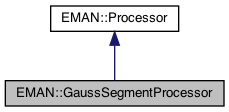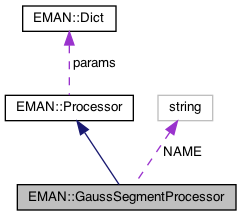Segment a volume by sequentially finding the highest peak and subtracting a Gaussian at that point from the density after strongly filtering the map to a specified resolvability. More...
#include <processor.h>


Public Member Functions | |
| string | get_name () const |
| Get the processor's name. More... | |
| virtual EMData * | process (const EMData *const image) |
| To proccess an image out-of-place. More... | |
| void | process_inplace (EMData *image) |
| To process an image in-place. More... | |
| TypeDict | get_param_types () const |
| Get processor parameter information in a dictionary. More... | |
| string | get_desc () const |
| Get the descrition of this specific processor. More... | |
 Public Member Functions inherited from EMAN::Processor Public Member Functions inherited from EMAN::Processor | |
| virtual | ~Processor () |
| virtual void | process_list_inplace (vector< EMData * > &images) |
| To process multiple images using the same algorithm. More... | |
| virtual Dict | get_params () const |
| Get the processor parameters in a key/value dictionary. More... | |
| virtual void | set_params (const Dict &new_params) |
| Set the processor parameters using a key/value dictionary. More... | |
Static Public Member Functions | |
| static Processor * | NEW () |
 Static Public Member Functions inherited from EMAN::Processor Static Public Member Functions inherited from EMAN::Processor | |
| static string | get_group_desc () |
| Get the description of this group of processors. More... | |
| static void | EMFourierFilterInPlace (EMData *fimage, Dict params) |
| Compute a Fourier-filter processed image in place. More... | |
| static EMData * | EMFourierFilter (EMData *fimage, Dict params) |
| Compute a Fourier-processor processed image without altering the original image. More... | |
Static Public Attributes | |
| static const string | NAME = "segment.gauss" |
Additional Inherited Members | |
 Public Types inherited from EMAN::Processor Public Types inherited from EMAN::Processor | |
| enum | fourier_filter_types { TOP_HAT_LOW_PASS , TOP_HAT_HIGH_PASS , TOP_HAT_BAND_PASS , TOP_HOMOMORPHIC , GAUSS_LOW_PASS , GAUSS_HIGH_PASS , GAUSS_BAND_PASS , GAUSS_INVERSE , GAUSS_HOMOMORPHIC , BUTTERWORTH_LOW_PASS , BUTTERWORTH_HIGH_PASS , BUTTERWORTH_HOMOMORPHIC , KAISER_I0 , KAISER_SINH , KAISER_I0_INVERSE , KAISER_SINH_INVERSE , SHIFT , TANH_LOW_PASS , TANH_HIGH_PASS , TANH_HOMOMORPHIC , TANH_BAND_PASS , RADIAL_TABLE , CTF_ } |
| Fourier filter Processor type enum. More... | |
 Protected Attributes inherited from EMAN::Processor Protected Attributes inherited from EMAN::Processor | |
| Dict | params |
Detailed Description
Segment a volume by sequentially finding the highest peak and subtracting a Gaussian at that point from the density after strongly filtering the map to a specified resolvability.
- Date
- 2021/04/18
Definition at line 1660 of file processor.h.
Member Function Documentation
◆ get_desc()
|
inlinevirtual |
Get the descrition of this specific processor.
This function must be overwritten by a subclass.
- Returns
- The description of this processor.
Implements EMAN::Processor.
Definition at line 1688 of file processor.h.
◆ get_name()
|
inlinevirtual |
Get the processor's name.
Each processor is identified by a unique name.
- Returns
- The processor's name.
Implements EMAN::Processor.
Definition at line 1663 of file processor.h.
References NAME.
◆ get_param_types()
|
inlinevirtual |
Get processor parameter information in a dictionary.
Each parameter has one record in the dictionary. Each record contains its name, data-type, and description.
- Returns
- A dictionary containing the parameter info.
Reimplemented from EMAN::Processor.
Definition at line 1671 of file processor.h.
References EMAN::EMObject::EMDATA, EMAN::EMObject::FLOAT, EMAN::EMObject::INT, and EMAN::TypeDict::put().
◆ NEW()
|
inlinestatic |
Definition at line 1683 of file processor.h.
◆ process()
To proccess an image out-of-place.
For those processors which can only be processed out-of-place, override this function to give the right behavior.
- Parameters
-
image The image will be copied, actual process happen on copy of image.
- Returns
- the image processing result, may or may not be the same size of the input image
Reimplemented from EMAN::Processor.
Definition at line 1448 of file processor.cpp.
References EMAN::EMUtil::EM_COMPRESSED, EMAN::Util::hypot3(), EMAN::EMUtil::IMAGE_UNKNOWN, EMAN::XYData::make_gauss(), EMAN::Processor::params, EMAN::Dict::set_default(), x, and y.
◆ process_inplace()
|
virtual |
To process an image in-place.
For those processors which can only be processed out-of-place, override this function to just print out some error message to remind user call the out-of-place version.
- Parameters
-
image The image to be processed.
Implements EMAN::Processor.
Definition at line 1441 of file processor.cpp.
Member Data Documentation
◆ NAME
|
static |
Definition at line 1693 of file processor.h.
Referenced by get_name().
The documentation for this class was generated from the following files: